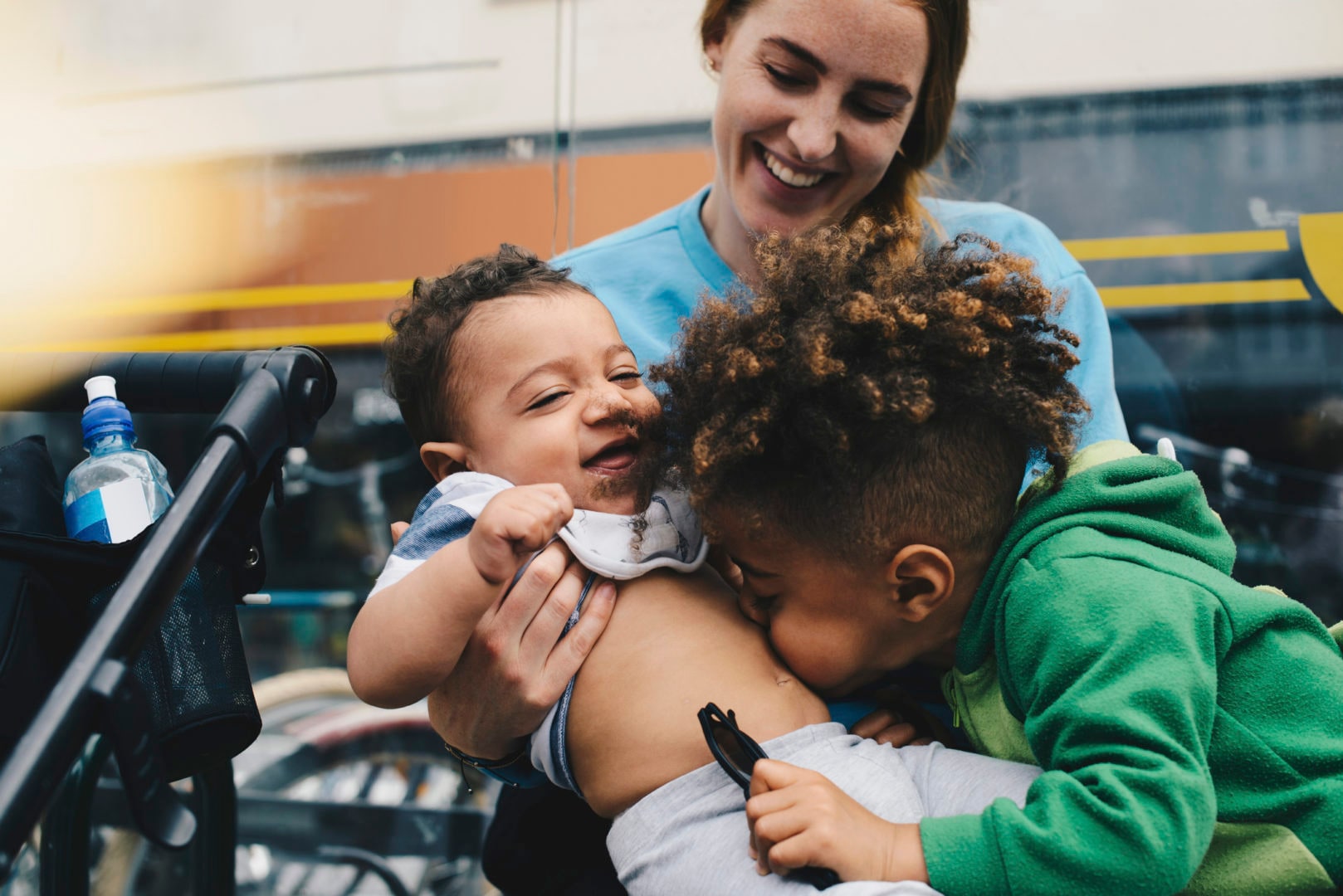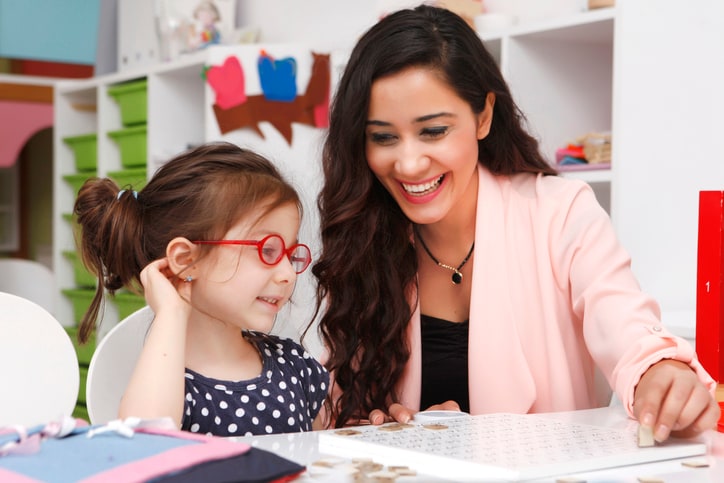Watching my 9-year-old daughter whiz trucks across the floor with her 18-month-old brother is one of those moments in time that makes a mother’s heart feel a sense of peace and delight. That’s because just a few hours earlier, the littlest needed a nap at the exact time that we needed to be in the car to pick up his fourth-grade sister from school. And more often than not, right when my little one is content with an activity, it’s also time to race to my older child’s swim class.
Having a gap of almost eight years between the two kids certainly brings out the innate nurturing in my oldest. But like any family dynamic, there are a set of challenges that come with the age difference. The biggest obstacle, however, is not the issue of scheduling but figuring out how to be present for both kids when they are at very different stages in their growth, interests and understanding of the world.
As you can imagine, providing care for a family with an age gap takes on a particular responsibility, as well. To provide insight for any caregiver dealing with this juggle, we spoke to a few experts about how to provide a fun, safe and harmonious setting when interacting and engaging with multiple children who are years apart.
1. Help older kids offset ‘helping’ with ‘playing’
“An older child is often given the task of being the ‘helper,’ but it is important to remember they are also a child and not responsible for a caregiving role,” says Katie Lockwood, an attending physician at Children’s Hospital in Philadelphia, Pennsylvania. “While having the older child help the younger child can sometimes be useful, this should be balanced by having them play.”
This certainly comes up in our household. We don’t want our daughter to feel like taking care of her brother is a burden or responsibility but do want her to feel a sense of pride in “helping out.” So, we are careful about the language we choose in asking for her help. Rather than, “Can you watch your brother while I make dinner?” — we try to say something like, “Sammy seems to be intrigued by the game you’re playing, do you think you can show him how it works?” This makes my daughter feel like she’s teaching him something, which gives her a sense of pride.
Afterward, we make sure to acknowledge that she was not only a great big sister by showing her brother how to count, sort or read, but she was also a big help to us while we were getting dinner ready. As Lockwood states above, we balance these helper moments with play by asking my daughter what activity she wants to do next.
2. Give each child one-on-one time
The next thing we try to be keenly aware of is the attention we give to both our kids. Obviously, younger kids, especially babies and toddlers, are going to require more hands-on attention than a school-aged child like our daughter. However, my daughter needs our time and attention, too. It just looks a little different.
“Recognizing the unique strengths, struggles and response styles in each child is one of the biggest pieces of advice I can offer parents and caregivers,” says Cindy T. Graham, a clinical psychologist in Columbia, Maryland.
Knowing this, we try to stress the importance of each person having one-on-one time within the family. While our daughter is at school, we have the opportunity to get on the floor with our son and he has my (or his dad’s) undivided attention. For our daughter, we usually leave the house for a bike ride, trip to the library or a local cafe. This ensures no interruptions from the little one.
I also make it a point to give subtle reminders that her brother won’t always need so much attention, but right now that’s how he learns and grows, just like when she was his age.
3. Balance the types of kids activities
When it comes to play time and interaction between children and parent or caregiver, it’s important all kids have a turn in choosing the activity, Lockwood advises.
“All children need to feel included, not just the oldest child who often is the most verbal,” says Lockwood.
With a little creativity, many activities have the ability to be something kids of different ages can enjoy.
“Balancing activities can mean finding the developmentally appropriate angle for each child,” says Graham.
Activities that are fun for most ages:
-
Imaginary play. Try initiating games that take imagination where both kids have a fun role, suggests Lockwood.
-
Blanket forts. When my oldest draped a blanket from her loft bed, my little guy thought it was so much fun to hide behind there. Now, they love building (and tearing down) places to hide together.
-
Museums. Lockwood recommends a museum outing where there is something for everyone.
-
Card games. With a younger child, this could mean focusing on turn-taking or color/shape recognition. With your older child, it can mean focusing on patience and good sportsmanship, Graham recommends.
-
Puppet show or a play. This could be an opportunity for the older child to “write” the script while the younger child can act out the scenes, Lockwood suggests.
-
Painting. My daughter loves to paint and her brother wants to do as she does. In this case, I give him water and a brush with construction paper. The wet streaks appear as regular brush strokes would, sans the mess.
4. Give praise for cooperative play
Whenever the children do a good job while playing together, Graham says to make sure to provide praise. Saying things like: “Great job finding the blue square” and “It was wonderful that you congratulated your little sister when she won” can go a long way in boosting cooperation and confidence.
While I find Graham’s advice of praising cooperation in the moment to be true with my kids, I also try to take it a step further with my oldest. At bedtime, when her ears seem to be most open, I remind her of what a kind thing it was she said or did for her brother. To me, this drives home the point that I’m paying attention and what she’s doing is special.
5. Leave room for alone time
The older a child gets, chances are, the more alone time they tend to desire, but playing solo has its benefits, even for toddlers.
“Older kids need to have their own private time respected, while younger kids need to learn independent play skills,” says Graham.
Graham also says one of the benefits of solo play is simply getting kids used to feeling comfortable when they are alone. Implementing this at a young age, and continuing to do so, instills confidence. Further, when boredom strikes, children will be able to rely on themselves versus someone else to entertain them.
In my experience, honoring this independence is an important part of a child’s growth as an individual. Since my daughter was a toddler, I wanted her to figure out as much as she could on her own and encouraged it whenever possible. To me, it fosters creativity and imagination but also creates a resilience in the sense of not giving up until you’ve tried all the options you can dream.






